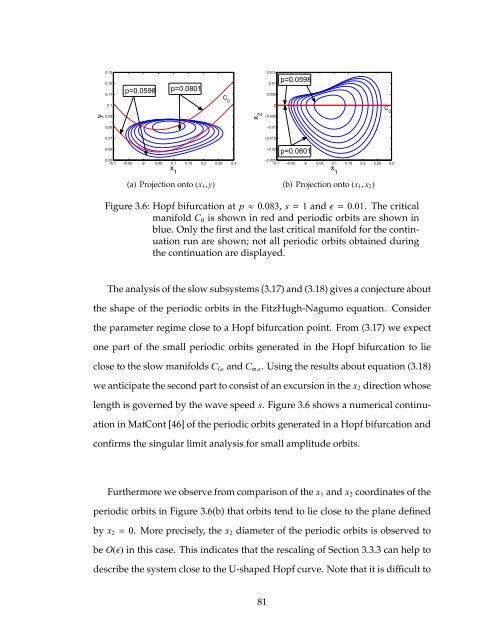multiple time scale dynamics with two fast variables and one slow ...
multiple time scale dynamics with two fast variables and one slow ...
multiple time scale dynamics with two fast variables and one slow ...
You also want an ePaper? Increase the reach of your titles
YUMPU automatically turns print PDFs into web optimized ePapers that Google loves.
y<br />
0.13<br />
0.12<br />
0.11<br />
0.1<br />
0.09<br />
0.08<br />
0.07<br />
0.06<br />
p=0.0598<br />
p=0.0801<br />
0.05<br />
−0.1 −0.05 0 0.05 0.1 0.15 0.2 0.25 0.3<br />
x 1<br />
(a) Projection onto (x1, y)<br />
C 0<br />
x 2<br />
0.015<br />
0.01<br />
0.005<br />
0<br />
−0.005<br />
−0.01<br />
−0.015<br />
−0.02<br />
p=0.0598<br />
p=0.0801<br />
−0.025<br />
−0.1 −0.05 0 0.05 0.1 0.15 0.2 0.25 0.3<br />
x 1<br />
(b) Projection onto (x1, x2)<br />
Figure 3.6: Hopf bifurcation at p≈0.083, s=1 <strong>and</strong>ǫ= 0.01. The critical<br />
manifold C0 is shown in red <strong>and</strong> periodic orbits are shown in<br />
blue. Only the first <strong>and</strong> the last critical manifold for the continuation<br />
run are shown; not all periodic orbits obtained during<br />
the continuation are displayed.<br />
The analysis of the <strong>slow</strong> subsystems (3.17) <strong>and</strong> (3.18) gives a conjecture about<br />
the shape of the periodic orbits in the FitzHugh-Nagumo equation. Consider<br />
the parameter regime close to a Hopf bifurcation point. From (3.17) we expect<br />
<strong>one</strong> part of the small periodic orbits generated in the Hopf bifurcation to lie<br />
close to the <strong>slow</strong> manifolds Cl,ǫ <strong>and</strong> Cm,ǫ. Using the results about equation (3.18)<br />
we anticipate the second part to consist of an excursion in the x2 direction whose<br />
length is governed by the wave speed s. Figure 3.6 shows a numerical continu-<br />
ation in MatCont [46] of the periodic orbits generated in a Hopf bifurcation <strong>and</strong><br />
confirms the singular limit analysis for small amplitude orbits.<br />
Furthermore we observe from comparison of the x1 <strong>and</strong> x2 coordinates of the<br />
periodic orbits in Figure 3.6(b) that orbits tend to lie close to the plane defined<br />
by x2= 0. More precisely, the x2 diameter of the periodic orbits is observed to<br />
be O(ǫ) in this case. This indicates that the rescaling of Section 3.3.3 can help to<br />
describe the system close to the U-shaped Hopf curve. Note that it is difficult to<br />
81<br />
C 0
















